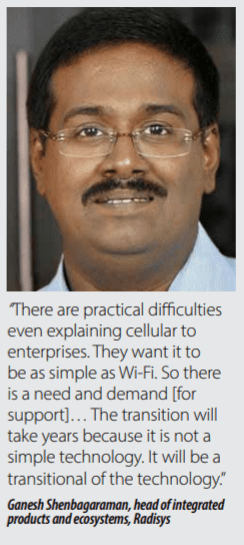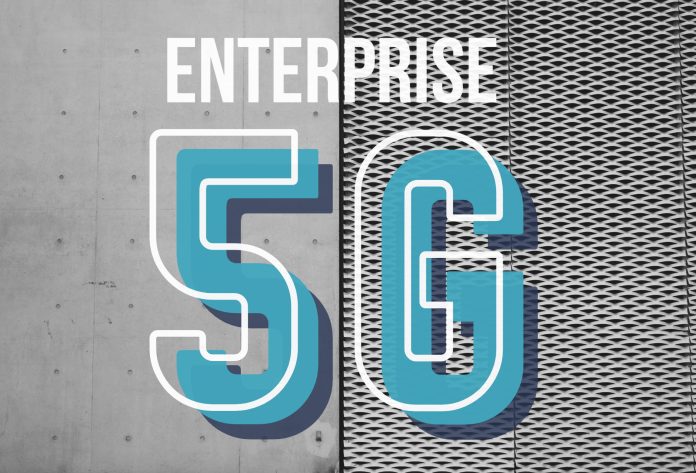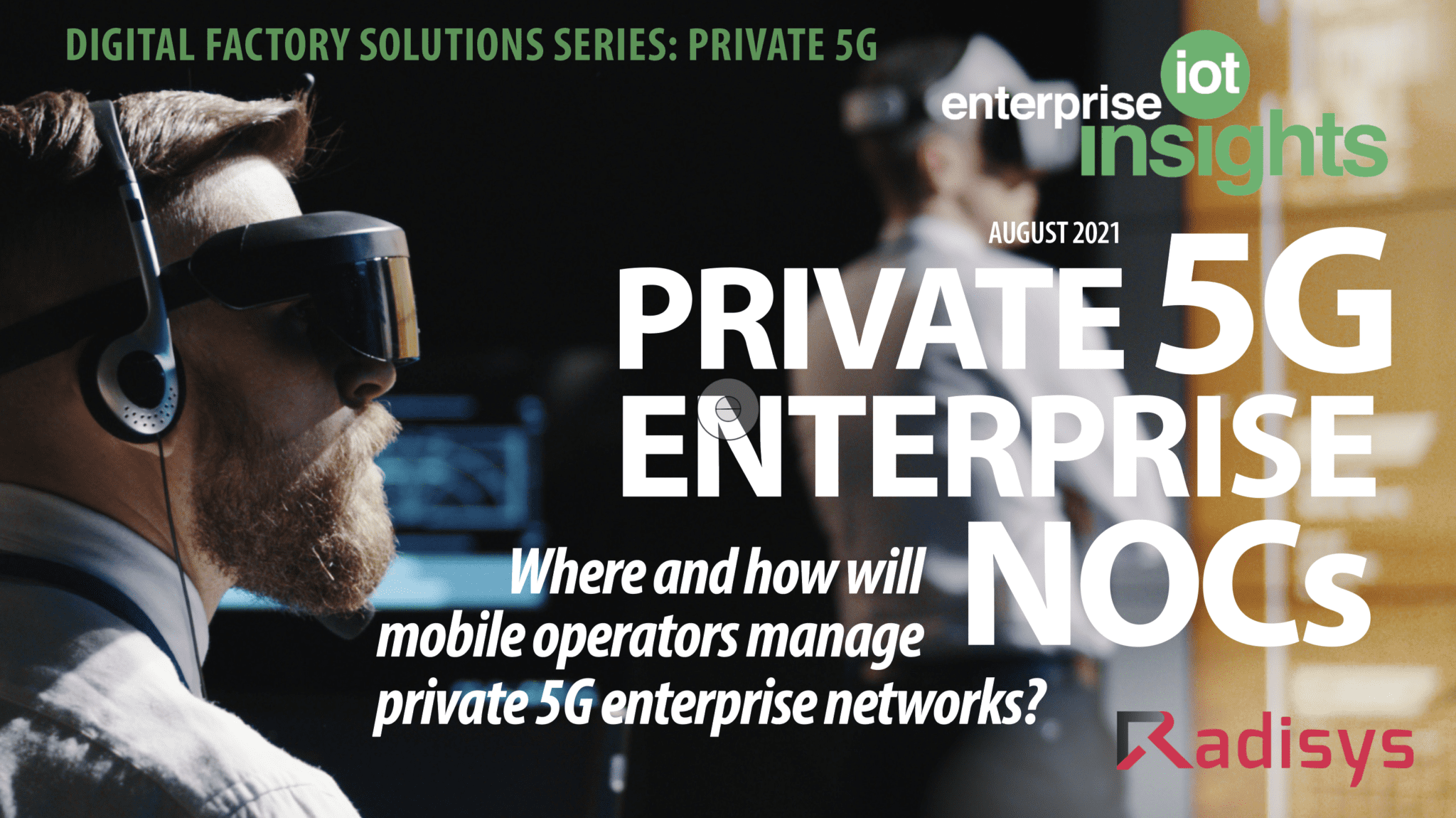Note, this article is taken from a longer editorial report on private 5G enterprise NOCs; to access the report, click here, or on the image below. For the attendant webinar on the same subject, including panellists from ABI Research, Vodafone, and Radisys, go here.
US-based Radisys, aligned with Indian operator Jio, has been looking to repurpose its core LTE product for private implementations since 2018, as a basis to provide a compact 5G core network solution. “We were using our inhouse LTE core for private networks. But with 5G, we’ve built everything from the ground up for private networks,” explains Ganesh Shenbagaraman, head of integrated products and ecosystems at the company.
In late 2019, the firm put a private 5G core into an operator lab to simulate a modified version of its network, testing for up to 57 base stations in standalone 5G, with support for throughput of about 20 Gbps in the user plane function (UPF). The simulation, it reckons, saw it scale its cut-down private 5G footprint from a few hundred to a few thousand users. “[We created a] low-end network-system in-a-box,” explains Shenbagaraman.
He says: “This gave us the building blocks for a compact [private] 5G core and RAN network strategy, based either on small cells, or a low-end CU/DU architecture – with the radio units coming from customers. It is an all-software offering… [and] a useful way to go with CBRS deployments in the US, for instance. So, we are moving towards a complete, end-to-end solution, offering the radio and core software, plus the management solution.”
Shenbagaraman gets into some of the minutiae of the management solution below, which is pitched to both operators and enterprises. But Radisys is playing the long game, building on experience building radio software for three decades, and on supply arrangements with the likes of Airspan Networks and Parallel Wireless. “We have only just entered this space… [but] we are confident of becoming well entrenched.”
It has a number of private 5G deals in the works, it says, without giving names. Some are white-label arrangements; one with a Europe-based industrial automation company. The mind boggles, easily. “More than a proof of concept,” is the line from Shenbagaraman. “These customers have two-year roadmaps, at least, and are moving swiftly. The solutions they have today are on Wi-Fi and they want to know how to migrate onto cellular.”
The private 5G software market is bubbling up; the likes of Athonet, Druid Software, Quortus, and Metaswitch are all knocking about. The market turns on collaboration, apparently, not just competition, especially for newer brands. “There will be a coexistence; no one will dominate. We do not see ourselves as a competitor to anyone. We partner with some of them – even if our solutions overlap in places, both sides know; it is done in a transparent fashion.”
What about network management, and the Radisys offer to operators and enterprises? Now we’re talking, and the whole conversation is taped below; all answers in the following section are from Shenbagaraman.
…
How do you see the supply-side battle over private 5G? What do you make of the opportunities for mobile operators to provide in-life management of private 5G?
“I see it in three layers. At the bottom, enterprises are making a move into the cellular space. But they are doing so with anxious minds. Because Wi-Fi, despite its flaws, is relatively easy to deploy, and more IT-like. And they have been dealing with Wi-Fi for decades. They are comfortable with Wi-Fi, whether Wi-Fi 6, or anything further. Whereas there are challenges with cellular – with the underlying complexity with the network and spectrum, and even with all the jargon.
 “There are practical difficulties even explaining cellular to enterprises. What they want is for the radios and base stations to be as simple and abstracted as Wi-Fi access points. So as a first layer, there is definitely a need, and a robust demand… The transition will take years because it is not a simple technology upgrade. So, it will be a transitional understanding of the technology.
“There are practical difficulties even explaining cellular to enterprises. What they want is for the radios and base stations to be as simple and abstracted as Wi-Fi access points. So as a first layer, there is definitely a need, and a robust demand… The transition will take years because it is not a simple technology upgrade. So, it will be a transitional understanding of the technology.
“The second dimension is the total cost of ownership (TCO), perceived to be more than with Wi-Fi. There is genuine concern among tech buyers about how much it is going to cost. Which is where operators [can offer] infrastructure sharing – and make it scale. The win-win is for operators to say to enterprises, ‘Leave the complexity of the 3GPP side, all the radio planning and troubleshooting, and all the integration with IT to me.’
“The ideal scenario is they do those things. And then the enterprises sign contracts that clearly lay out responsibilities about what IT enterprise managers have visibility of, and the kinds of guarantees of security, and all of these things. And the operator-side manages the private network like an extension of their infrastructure – beyond what they do in the public network.
“But the third layer is with the hyperscalers: Microsoft, Google, Amazon. I am watching with interest, because right now, they are all saying they are here to help the operators, providing the cloud infrastructure, the sophisticated software management orchestration, and cloud instances, and all the strengths a hyperscaler brings in terms of virtualizing and managing everything, and dynamically scaling up and down.
“Today, hyperscalers are engaging with the network vendors too. Nokia, and many of the OEMs, are putting their products in Azure or AWS. So, the vendors are, in a sense, hosting an operator’s network, and also hosting a hyperscaler’s network, as well.”
Explain your managed service proposition for operators and enterprises?
“We are looking at all aspects of providing the RAN and core network connectivity. The thing we have realised is the native operators, not the hyperscalers, want to develop these [network management capabilities]. And we bring in the system integration (SI) expertise. They may still need a domain specific SI, but when it comes to the RAN and core network for the wireless piece, we know how to do the end-to-end integration.
“We have done this for IoT devices, and for different types of smartphones, so we bring that. The other thing is edge computing, bringing the necessary workloads and applications to solve specific use cases – for example, analytical use cases where high quality video transfer. We have the portfolio to do that. And sometimes we will partner with a company like Intel to bring in their hardware acceleration for AI and ML. That is at the application level.
“So we are addressing all these three levels: as the connectivity layer provider, as the system integrator, and at the application or code related level. That is how we will play. And we are looking [to engage with] traditional operators. We have a direct relationship with operators in the US, including with MSOs (multiple system operators), acquiring CBRS spectrum to become wireless providers. We see future alignment with Jio in India, as well – which can provide some of these aspects from an infrastructure sharing perspective to Radisys.”
If we hop back to the design phase – carrying into management, too – talk around the kinds of performance SLAs that are going against these private 5G networks?
“These are early stages. We have a network services team, a small group attached to a larger group within Jio, which runs the [public] network on a day-to-day basis. We have designed templates about [SLAs] for different-sized private networks – from RF planning to the KPIs to monitor [performance]… We cannot claim experience from lots of [private network] deployments right now, because there are only two or three places where we are doing this today. But a year down the line, we will be able to talk about how we’ve been doing it, [and] our own unique way.”
Talk about how private 5G NOCs will be organised, and how the support model for enterprise 5G will develop.
“Despite the promise, the industry is in the early phase of deployment. This has to be scaled gradually. The same equipment that worked for macro public networks cannot be used in private networks – just for cost reasons, mainly. So, when we supply these simpler, lower-power networks, there will [inevitably] be some component failures, and equipment issues. Even for well stitched-together solutions, expansion will happen gradually, with a number of learning cycles to know what fails, under what conditions.
“The technology is still – well, it is not that it is immature, but it is not-so institutionalised to roll out at scale for any particular vertical. It has to be a gradual increase – [and it has to be a gradual process to define] mechanisms to be sure the network is always on, 24/7, and to remediate component failures. In reality [in the early days], there will be a local partner to provide emergency support, which knows the deployment and can go and replace a part if required.”
You mentioned the challenges with the underlying complexity in cellular; but will cellular be as easy as Wi-Fi at some point? Where does that leave operators?
“But the operators will change shape as well, by adding more analytics and more sophisticated services. We have to assume the operators will evolve to a higher level of analytics. There are aspects in the open RAN architecture that make the application of data and analytics possible. Industry specific analytics will bring new value [to enterprise networks], and operators will go beyond just solving basic connectivity problems. Because industrial 5G is not just about networking equipment; it is about benchmarking downtime and maximising the utilisation of equipment.
“If you look at the market over the last decade, the unanswerable question has been how long it will take to make IoT a reality. Because the IoT market has been so fragmented – with so many overlapping technologies. At least there is some consolidation with 5G. The entry of the hyperscalers, even though they are disruptive, will lead to consolidation as well, and some benefits for the industry. In five years, the industry will be in a stabler situation. Certain offerings will be well-standardised, like private cellular networks, and easy for the average enterprise to pick up.
“Like with Wi-Fi, where an enterprise IT administrator knows, this is my network, my users, my usage pattern. That level of well-defined choice is not available in the wireless space today. So, in five years, say, enterprises will be able to more easily evaluate what’s available in terms of cost, features, packaging. That will be a real milestone for private cellular. But the technology needs to evolve in the meantime.”
And to be clear, when the hardware is easy for enterprises to ‘pick up’, will there be a need for third-party management?
“Yes, there will be a need, of course, because many enterprises will choose not to deal with it themselves. They will outsource. If they have 100 private networks in 100 factories in 100 locations, say, and need to manage connectivity between all of those ‘islands’ – and someone has to run all of that. And enterprises won’t, typically. Because the issue of skills remains a concern for enterprises, and they are better off hiring this as-a-service than recruiting expertise themselves.”
Note, this article is taken from a longer editorial report on private 5G enterprise NOCs; to access the report, click here, or on the image below. For the attendant webinar on the same subject, including panellists from ABI Research, Vodafone, and Radisys, go here.



